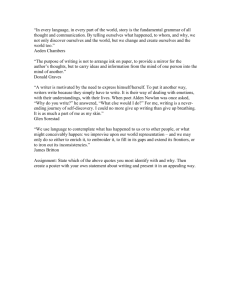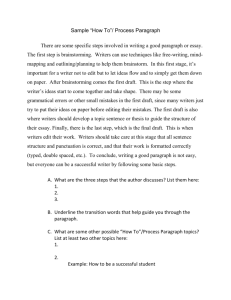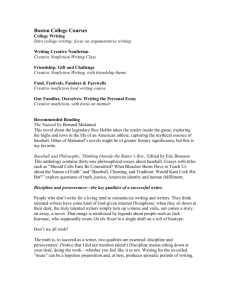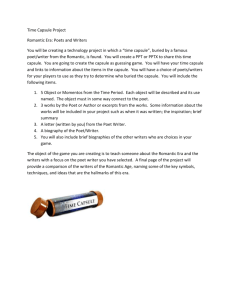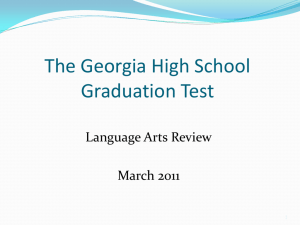American Literature Timeline
advertisement
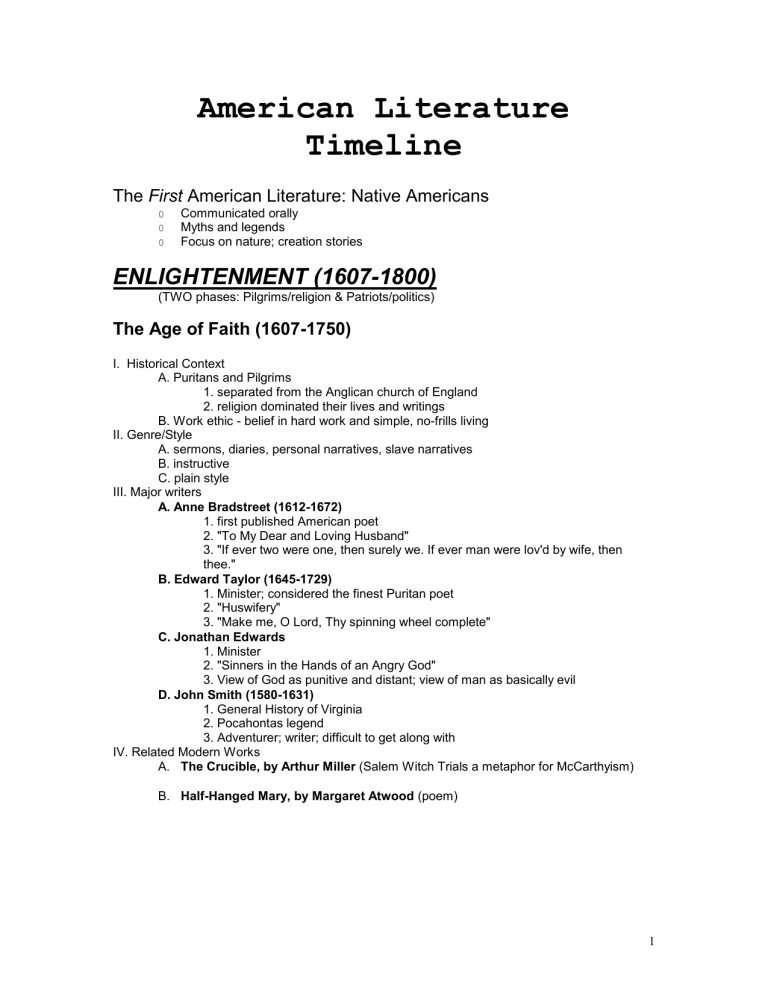
American Literature Timeline The First American Literature: Native Americans 0 0 0 Communicated orally Myths and legends Focus on nature; creation stories ENLIGHTENMENT (1607-1800) (TWO phases: Pilgrims/religion & Patriots/politics) The Age of Faith (1607-1750) I. Historical Context A. Puritans and Pilgrims 1. separated from the Anglican church of England 2. religion dominated their lives and writings B. Work ethic - belief in hard work and simple, no-frills living II. Genre/Style A. sermons, diaries, personal narratives, slave narratives B. instructive C. plain style III. Major writers A. Anne Bradstreet (1612-1672) 1. first published American poet 2. "To My Dear and Loving Husband" 3. "If ever two were one, then surely we. If ever man were lov'd by wife, then thee." B. Edward Taylor (1645-1729) 1. Minister; considered the finest Puritan poet 2. "Huswifery" 3. "Make me, O Lord, Thy spinning wheel complete" C. Jonathan Edwards 1. Minister 2. "Sinners in the Hands of an Angry God" 3. View of God as punitive and distant; view of man as basically evil D. John Smith (1580-1631) 1. General History of Virginia 2. Pocahontas legend 3. Adventurer; writer; difficult to get along with IV. Related Modern Works A. The Crucible, by Arthur Miller (Salem Witch Trials a metaphor for McCarthyism) B. Half-Hanged Mary, by Margaret Atwood (poem) 1 The Age of Reason (1750-1800) I. Historical context A. American Revolution; growth of patriotism B. Development of American character/democracy C. Use of reason as opposed to faith alone II. Genre/Style A. political pamphlets, essays, travel writing, speeches, documents B. instructive in values; highly ornate writing style III. Major writers A. Abigail Adams (wife of John Adams) 1. In letters, Abigail Adams campaigned for women's rights 2. Provided a glimpse of the Rev. period B. Ben Franklin 1. Autobiography & Poor Richard's Almanac 2. Symbol of success gained by hard work and common sense 3. "Early to bed, early to rise, makes a man healthy, wealthy, and wise." 4. "God helps them that help themselves." 5. "Haste makes waste." C. Thomas Jefferson 1. Declaration of Independence 2. Considered the finest writer of the era 3. "We hold these truths to be self-evident: that all men are created equal…" D. Thomas Paine 1. Pamphleteer 2. "The American Crisis" helped propel us into war 3. Remains a model of effective propaganda 4. "These are the times that try men's souls." 2 ROMANTICISM (1800-1855) I. Historical context A. Expansion of book publishing, magazines, newspapers B. Industrial Revolution C. Abolitionist movement II. Genre/Style A. Short stories, novels, poetry, B. Imagination over reason; intuition over fact C. Focused on the fantastic of human experience D. Writing that can be interpreted 2 ways: surface and in depth E. Focus on inner feelings F. Gothic literature (sub-genre of Romanticism) 1. Use of the supernatural 2. Characters with both evil and good characteristics 3. Dark landscapes; depressed characters III. Major writers A. Washington Irving (1789-1851) 1. first famous American writer; called "father of American Lit" 2. wrote short stories, travel books, satires 3. Legend of Sleepy Hollow: terrified generations of children 4. Rip Van Winkle: created success from failure; the antihero 5. "Devil and Tom Walker": an encounter-with-the-devil tale B. Nathaniel Hawthorne (1804-1864) 1. wrote about sin and guilt; consequences of pride, selfishness, etc. 2. The Scarlet Letter 3. Short stories ("The Minister's Black Veil") C. Edgar Allen Poe (1809-1849) 1. lousy childhood; substance abuse problems; reviled in his day 2. created the modern short story and detective story 3. Poems: "The Raven", "Bells", "Annabel Lee", "Dream" 4. Attacked 2 long-standing conventions: a poem has to be long; it must teach a lesson 5. Short stories: "Fall of the House of Usher", "Pit and the Pendulum" 6. inspired future detective/horror stories: Sherlock Holmes, Norman Bates, Freddy Kruger, etc. D. Herman Melville (1819-1891) 1. ranked as one of America's top novelists, but recognized by few in his own time 2. Moby Dick a. didn't sell: only his friend NH liked it; not reprinted for 60 yrs. b. now considered America's greatest prose epic 3 The Transcendentalists (1840-1855) 1. Transcendentalism: stressed individualism, intuition, nature, self-reliance 2. Ralph Waldo Emerson (1803-1882) a. his writings helped establish the philosophy of individualism, an idea deeply embedded in American culture b. "Nature" c. "Self-Reliance" 3. Henry David Thoreau (1817-1862) a. resisted materialism; chose simplicity, individualism b. Walden 1. lived on Walden Pond for 2+ years 2. a guidebook for life, showing how to live wisely in a world designed to make wise living impossible c. "Civil Disobedience": a primer for nonviolent protest New Poetic Forms 1. Walt Whitman (1819-1892) a. rejected conventional themes, forms, subjects b. used long lines to capture the rhythm of natural speech, free verse, everyday vocabulary c. "Song of Myself" d. "I Hear America Singing" e. "O Captain My Captain" 2. Emily Dickinson (1830-1886) a. her poetry broke with convention: didn't look right; didn't rhyme; too bold; too radical b. concrete imagery, forceful language, unique style d. wrote 1775 poems, published only 7 in her life e. "Because I could not stop for Death--" f. “My life closed twice before its close—“ g. “The Soul selects her own Society—“ 3. Henry Wadsworth Longfellow “A Psalm of Life” 4. William Cullen Bryant 5. Oliver Wendell Holmes 6. James Russell Lowell “The First Snowfall” 7. Paul Laurence Dunbar “We Wear the Mask” 8. Edwin A. Robinson “Richard Cory” 4 REALISM (1865-1915) I. Historical context A. Civil War brings demand for a "truer" type of literature that doesn't idealize people or places B. People in society defined by "class"; materialism C. Reflect ideas of Darwin (survival of the fittest) and Marx (how money and class structure control a nation) II. Genre/Style A. Realism 1. a reaction against romanticism; told it like it was 2. focus on lives of ordinary people; rejected heroic and adventurous 3. anti-materialism; rejected the new "class" system 4. view of nature as a powerful and indifferent force beyond man's control B. Naturalism (sub-genre of Realism) 1. like Realism but a darker view of the world 2. the universe is unpredictable; fate is determined by chance; free will is an illusion 3. characters' lives shaped by forces they can't understand or control C. Novels, short stories D. Often aims to change a specific social problem E. Dominant themes: survival, fate, violence, nature as an indifferent force III. Major writers A. The Civil War (1855-1865) 1. Harriet Beecher Stowe (1811-1896) a. The most famous woman of her day b. Uncle Tom's Cabin (1). most influential book of the 19th Century; 1st to sell 1 mil. copies (2). one of the most effective documents of propaganda; helped fuel the Civil War 2. Frederick Douglas (1817-1895) a. an escaped slave; one of the most effective orators of his day b. influential newspaper writer; militant abolitionist; diplomat c. autobiography an instant and enduring classic of courage B. The Frontier (1865-1915) 1. Mark Twain (1835-1910) a. Samuel Langhorne Clemens is widely thought to be the greatest American humorist and one of our greatest novelists b. used vernacular, exaggeration, deadpan narrator to create humor c. Celebrated Jumping Frog of Calaveras County (tall tale) d. Adventures of Tom Sawyer e. Adventures of Huckleberry Finn (one of America's most influential novels) f. Life on the Mississippi (a memoir) g. The Prince and the Pauper h. A Connecticut Yankee in King Arthur's Court 2. Stephen Crane (1871-1900) (Naturalist) a. Crane attacked patriotism, individualism, organized religion; confronted the meaninglessness of the world b. Crane's writing known for its images & symbolism c. Red Badge of Courage (most famous work; set in Civil War) d. The Open Boat (man vs Nature's indifference) e. An Episode of War (short story) 5 3. Jack London a. pushed Naturalism to its limits b. Call of the Wild (tame dog forced to revert to his original primitive state) c. To Build a Fire (survival of the fittest) 4. The Local Colorists (1865-1930) a. Regional writers tried to capture the essence of a particular area, or its "local color" b. Bret Harte (1836-1902) (1). the Old West (2). Outcasts of Poker Flat c. Kate Chopin (1851-1904) (1). the Louisiana bayou (2). The Awakening d. Willa Cather (1873-1947) (1). life on the Nebraska prairie (2). won Pulitzer Prize Modernism (1915-1945) I. Historical context A. Overwhelming technological changes B. World War I first war of mass destruction C. Grief over loss of past; fear of eroding traditions D. Rise of youth culture II. Genre/Style A. Dominant mood: alienation/disconnection B. Writing highly experimental: use of fragments, stream of consciousness, interior dialogue C. Writers seek to create a unique style III. Major writers A. Ernest Hemingway (1899-1961) 1. Writing style: concise, direct, spare, objective, precise, rhythmic 2. Major works include The Sun Also Rises, A Farewell to Arms, For Whom the Bell Tolls, The Old Man and the Sea 3. a larger than life hero; big game hunter; sport fisherman; headliner; won Pulitzer Prize and Nobel Prize for Literature B. F.Scott Fitzgerald (1896-1940) 1. The Great Gatsby (ironic and tragic treatment of the American success myth) 2. his work and life illustrate American culture of the 1920's C. William Faulkner (1897-1962) 1. As I Lay Dying 2. The Sound and the Fury (his masterpiece) C. the most original writer of his time D. primary subject was his heritage: Southern memory, reality, myth D. John Steinbeck 1. Grapes of Wrath (combined naturalism & symbolism to express outrage and compassion for the plight of the farmers displaced by the Depression & Dustbowl) 2. Of Mice and Men 3. The Pearl 4. belief in the need for social justice; hope that people can learn from the suffering of others IV. Major 20th Century poets 6 (Pound & Eliot were the 2 most influential poets and critics of their era. They dictated the tone, direction, and subject matter for a generation of poets.) A. Ezra Pound A. Imagism (ordinary language, free verse, concentrated word pictures) B. Committed treason C. spent a decade in a mental hospital B. T. S. Eliot 1. Love Song of J. Alfred Prufrock (what is our place in the universe? how can anyone love and communicate with anyone else?) 2. The Waste-Land (the failure of Western civilization, illustrated by WWI) C. Robert Frost (1874-1963) 1. America's best known and best-loved poet 2. traditional verse forms; plain speech of rural New Englanders 3. Death of the Hired Man 4. Birches 5. Stopping by Woods on a Snowy Evening 6. The Road Not Taken 7. Mending Wall D. e. e. cummings 1. Edward Estlin 2. played around with form, punctuation, spelling, type style, grammar, imagery, rhythm, syntax E. Carl Sandburg 1.one of the Chicago poets 2. describes everyday Americans, positive tone, simple words, easy to understand, free verse V. The Harlem Renaissance (1915-1929) A. A black cultural movement that emerged in Harlem during the 20's; literature, music and art flourished B. Langston Hughes: most successful black writer in America; wrote poetry, drama, novels, songs, movie scripts, etc. C. Countee Cullen: the "black Keats" for his youth, skill as a poet, use of traditional forms D. Zora Neale Hurston: rediscovered by the women's movement in the 70's E. Jean Toomer: "Cane" regarded as one of the most influential works of the era F. Claude McKay: poetry evokes the heritage of his native Jamaica CONTEMPORARY (1945-present) I. Historical context A. Media saturated culture: people observe life as media presents it rather than experiencing life directly B. Insistence that values are not permanent but only "local" or "historical"; media culture interprets values C. Post WWII prosperity D. People beginning a new century and new millennium E. Social protest II. Genre/Style A. Lines of reality blurred; mix of fantasy and nonfiction B. No heroes/Anti-heroes C. Concern with individual in isolation D. Detached, unemotional, usually humorless E. Emergence of ethnic and women writers III. Major writers A. Beat writers (pre-hippie, highly intellectual, anti-Tradition) 1. William S. Burroughs (Naked Lunch) 7 2. Jack Kerouac (On the Road) 3. Allen Ginsberg (Howl) 4. countered the hidden despair of the 50's with wildly exuberant language and behavior B. Confessional poets 1. Sylvia Plath (most famous; suicide) 2. Anne Sexton (Pul. Prize; suicide) 3. Robert Lowell (10 volumes of brilliant anguished work) 4. used the anguish of their own lives to explore America's hidden despair C. J. D. Salinger (Catcher in the Rye became the symbol for a generation of disaffected youth) D. Flannery O'Conner (Southern Gothic) E. James Thurber (America's most popular humorist in 30's & 40's; The Secret Life of Walter Mitty) F. Multicultural Literature 1. Jewish American literature (50's & 60's) a. Bernard Malamud 1914-1986 (The Natural; myth-maker, parables) b. Elie Wiesel b.1928 (holocaust survivor) 2. African American literature (rise of black militancy and the civil rights movement in the 50's and 60's) a. Ralph Ellison 1914-1994 (Invisible Man: theme that society willfully ignores blacks) b. Gwendolyn Brooks b.1917 (1st black female poet to win Pul. Prize; We Real Cool) c. Maya Angelou b.1928 (I Know Why the Caged Bird Sings; strong African-American women) d. Alice Walker b.1944 (The Color Purple: poor oppressed black women in early 1900's) 3. Native American literature a. N. Scott Momaday b.1934 b. Louise Erdrich b.1954 4. Latino-American literature a. Julia Alvarez b.1950 b. Sandra Cisneros b.1954 5. Asian-American literature a. Maxine Hong Kingston b.1940 b. Amy Tan b.1952 G. New Frontiers I. John Updike (b.1932) A. Witches of Eastwick B. Protestant small-town middle-class life II. Truman Capote (1924-1984) A. In Cold Blood B. the nonfiction novel III. Stephen King (b.1947) A. Carrie, The Shining, Salem's Lot, The Stand, etc. B. thrilling psychological horror C. best-selling novelist ever D. pen name: Richard Bachman IV. Joyce Carol Oates (b. 1938) A. great versatility B. one of the most productive contemporary writers 8

